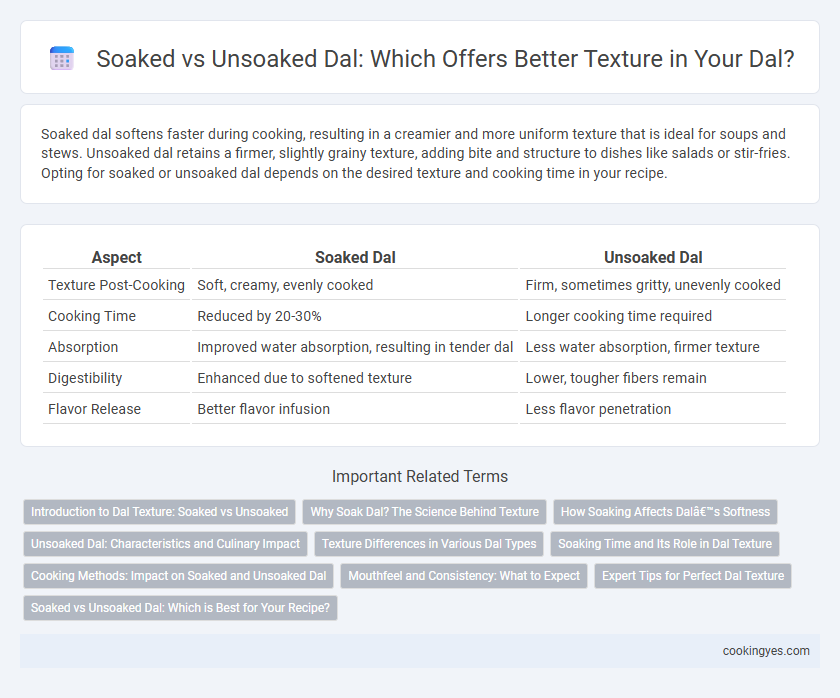Soaked dal softens faster during cooking, resulting in a creamier and more uniform texture that is ideal for soups and stews. Unsoaked dal retains a firmer, slightly grainy texture, adding bite and structure to dishes like salads or stir-fries. Opting for soaked or unsoaked dal depends on the desired texture and cooking time in your recipe.
Table of Comparison
| Aspect | Soaked Dal | Unsoaked Dal |
|---|---|---|
| Texture Post-Cooking | Soft, creamy, evenly cooked | Firm, sometimes gritty, unevenly cooked |
| Cooking Time | Reduced by 20-30% | Longer cooking time required |
| Absorption | Improved water absorption, resulting in tender dal | Less water absorption, firmer texture |
| Digestibility | Enhanced due to softened texture | Lower, tougher fibers remain |
| Flavor Release | Better flavor infusion | Less flavor penetration |
Introduction to Dal Texture: Soaked vs Unsoaked
Soaked dal absorbs water, resulting in a softer, creamier texture that cooks faster and enhances digestibility. Unsoaked dal retains a firmer, slightly grainy texture, requiring longer cooking times and producing a more distinct shape in dishes. Understanding the impact of soaking on dal texture is essential for achieving desired culinary results and optimizing nutrient availability.
Why Soak Dal? The Science Behind Texture
Soaking dal hydrates the lentil grains, reducing cooking time and promoting even heat penetration, which results in a softer, creamier texture. The water absorption activates enzymes that begin breaking down starches and proteins, enhancing digestibility and creating a smoother consistency. Unsoaked dal retains a firmer texture due to limited water infiltration, leading to longer cooking and uneven softening.
How Soaking Affects Dal’s Softness
Soaking dal significantly softens the lentils by hydrating them, which reduces overall cooking time and produces a creamier texture. Unsoaked dal requires longer cooking and often results in a firmer, grainier consistency due to the lack of pre-hydration. The degree of softness achieved through soaking varies with dal type, with smaller lentils like masoor dal benefiting most from this process.
Unsoaked Dal: Characteristics and Culinary Impact
Unsoaked dal retains a firmer texture and takes longer to cook compared to soaked dal, which softens and reduces cooking time significantly. Cooking unsoaked dal often results in a nuttier flavor and a more robust, grainy consistency that enhances dishes requiring a distinct dal structure. This characteristic makes unsoaked dal ideal for recipes like dals with chunky textures or for slow-cooking methods that develop deeper flavors.
Texture Differences in Various Dal Types
Soaked dal absorbs water, resulting in a softer, creamier texture that cooks faster and breaks down more easily, ideal for dishes like dal tadka and khichdi. Unsoaked dal retains a firmer, chewier texture, providing a more distinct bite, often preferred in recipes requiring whole pulses such as chana dal or toor dal. Different types of dal, including moong, masoor, and urad, show varying texture changes when soaked, influencing cooking time and the final mouthfeel of the dish.
Soaking Time and Its Role in Dal Texture
Soaking dal for at least 30 minutes to several hours significantly softens the pulses, leading to a creamier texture and faster cooking time. Unsoaked dal tends to retain a firmer texture and requires prolonged cooking, which can result in unevenly cooked lentils. Proper soaking hydrates the dal uniformly, enhancing its digestibility and contributing to a smooth, tender consistency in the final dish.
Cooking Methods: Impact on Soaked and Unsoaked Dal
Soaked dal significantly reduces cooking time and results in a softer, creamier texture due to the absorbed water allowing heat to penetrate easily. Unsoaked dal requires longer cooking and often yields a firmer, less even texture because the heat takes more time to permeate the dry lentils. Pressure cooking enhances the softness of soaked dal while slow simmering helps maintain structure in unsoaked dal, influencing final texture based on the cooking method used.
Mouthfeel and Consistency: What to Expect
Soaked dal softens the lentils, resulting in a creamier and smoother mouthfeel with even consistency when cooked. Unsoaked dal tends to retain a firmer texture and grainier consistency, often requiring longer cooking times to achieve tenderness. The soaking process enhances water absorption, which contributes to improved digestibility and a more uniform texture in the final dish.
Expert Tips for Perfect Dal Texture
Soaked dal reduces cooking time and results in a softer, creamier texture due to pre-hydration of the lentils, while unsoaked dal retains a firmer, slightly grainy consistency. Experts recommend soaking dal for at least 30 minutes to achieve an even cook and prevent splitting, essential for dishes like dal tadka or dal makhani. For perfectly textured dal, controlling soaking time and cooking temperature ensures balanced softness without overcooking.
Soaked vs Unsoaked Dal: Which is Best for Your Recipe?
Soaked dal absorbs water, reducing cooking time and resulting in a softer, creamier texture ideal for dals and soups, while unsoaked dal retains a firmer texture suitable for salads and dishes requiring more bite. Nutrient bioavailability improves with soaking, enhancing digestibility and nutrient absorption compared to unsoaked dal. Choosing between soaked vs unsoaked dal depends on recipe requirements, desired texture, and cooking duration preferences.
Soaked Dal vs Unsoaked Dal for Texture Infographic

 cookingyes.com
cookingyes.com